Contemporary Practice Issues Report: Healthcare Practice, Module 2
VerifiedAdded on 2019/11/08
|11
|2730
|393
Report
AI Summary
This reflective report addresses contemporary practice issues across five subject modules within a healthcare context. It begins with clinical governance, exploring ways to improve consumer participation in healthcare delivery and how a registered nurse can facilitate this. The report then delves into quality and safety, examining a national standard for infection control, associated risks, and strategies for enhancing patient outcomes. Leadership and management are discussed, highlighting leadership skills in nursing, mentorship strategies, and the development of a positive organizational culture. Professional practice challenges, such as role conflict and self-care strategies for nurses, are also considered. The author provides personal reflections and practical strategies for improving patient care and professional development within each area, offering valuable insights for healthcare professionals seeking to enhance their practice and improve patient outcomes. The report emphasizes the importance of evidence-based practices and continuous improvement in healthcare settings.
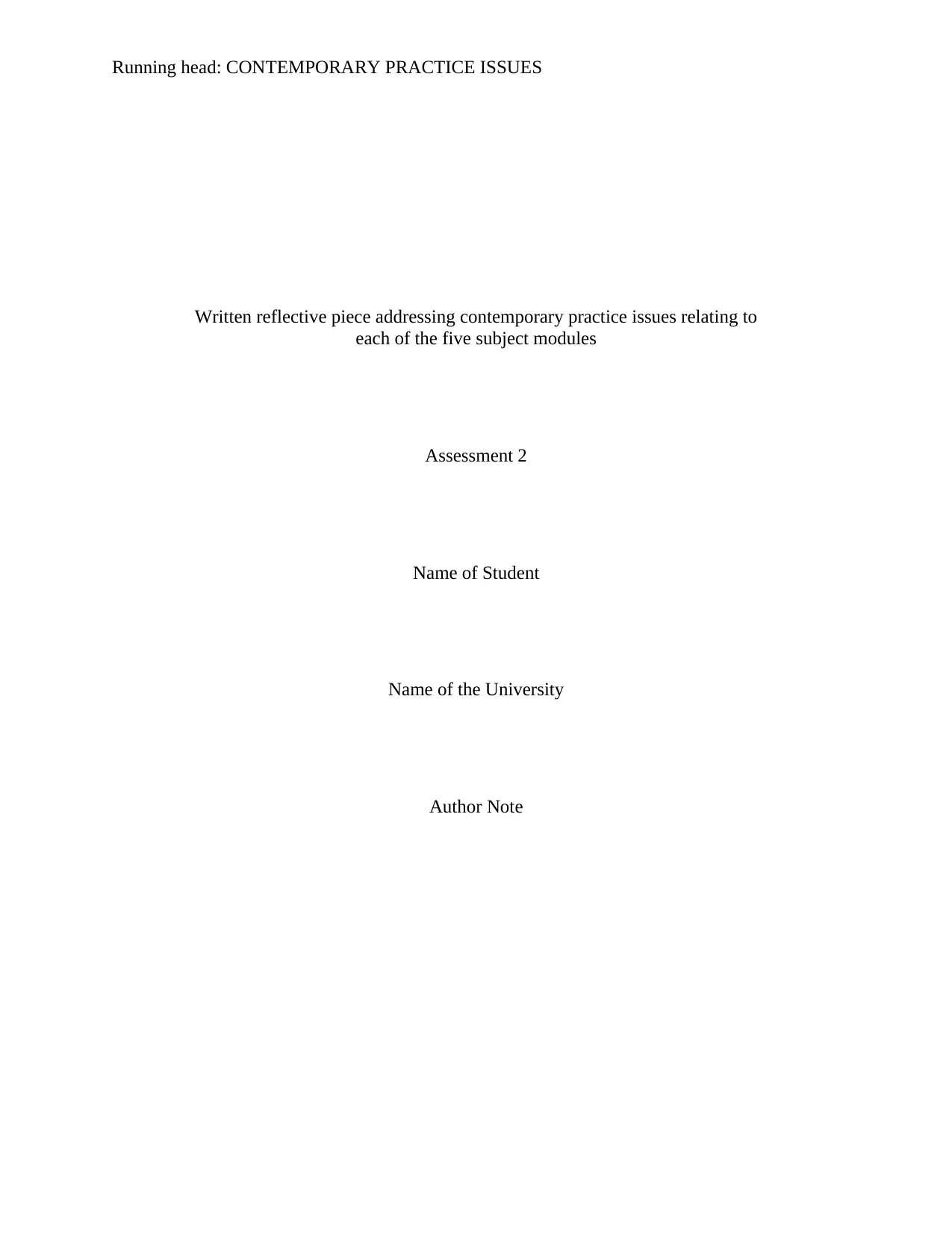
Running head: CONTEMPORARY PRACTICE ISSUES
Written reflective piece addressing contemporary practice issues relating to
each of the five subject modules
Assessment 2
Name of Student
Name of the University
Author Note
Written reflective piece addressing contemporary practice issues relating to
each of the five subject modules
Assessment 2
Name of Student
Name of the University
Author Note
Paraphrase This Document
Need a fresh take? Get an instant paraphrase of this document with our AI Paraphraser
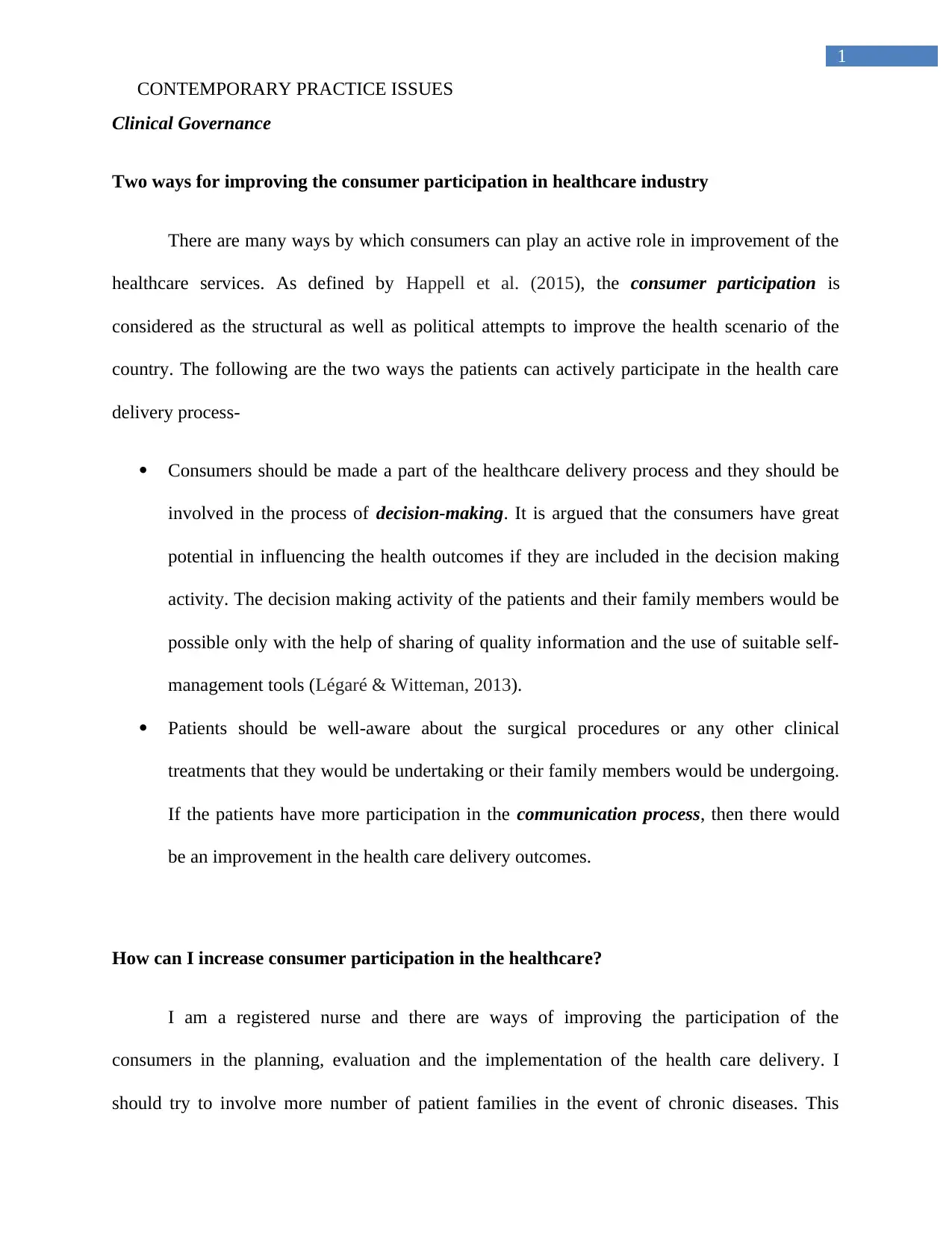
1
CONTEMPORARY PRACTICE ISSUES
Clinical Governance
Two ways for improving the consumer participation in healthcare industry
There are many ways by which consumers can play an active role in improvement of the
healthcare services. As defined by Happell et al. (2015), the consumer participation is
considered as the structural as well as political attempts to improve the health scenario of the
country. The following are the two ways the patients can actively participate in the health care
delivery process-
Consumers should be made a part of the healthcare delivery process and they should be
involved in the process of decision-making. It is argued that the consumers have great
potential in influencing the health outcomes if they are included in the decision making
activity. The decision making activity of the patients and their family members would be
possible only with the help of sharing of quality information and the use of suitable self-
management tools (Légaré & Witteman, 2013).
Patients should be well-aware about the surgical procedures or any other clinical
treatments that they would be undertaking or their family members would be undergoing.
If the patients have more participation in the communication process, then there would
be an improvement in the health care delivery outcomes.
How can I increase consumer participation in the healthcare?
I am a registered nurse and there are ways of improving the participation of the
consumers in the planning, evaluation and the implementation of the health care delivery. I
should try to involve more number of patient families in the event of chronic diseases. This
CONTEMPORARY PRACTICE ISSUES
Clinical Governance
Two ways for improving the consumer participation in healthcare industry
There are many ways by which consumers can play an active role in improvement of the
healthcare services. As defined by Happell et al. (2015), the consumer participation is
considered as the structural as well as political attempts to improve the health scenario of the
country. The following are the two ways the patients can actively participate in the health care
delivery process-
Consumers should be made a part of the healthcare delivery process and they should be
involved in the process of decision-making. It is argued that the consumers have great
potential in influencing the health outcomes if they are included in the decision making
activity. The decision making activity of the patients and their family members would be
possible only with the help of sharing of quality information and the use of suitable self-
management tools (Légaré & Witteman, 2013).
Patients should be well-aware about the surgical procedures or any other clinical
treatments that they would be undertaking or their family members would be undergoing.
If the patients have more participation in the communication process, then there would
be an improvement in the health care delivery outcomes.
How can I increase consumer participation in the healthcare?
I am a registered nurse and there are ways of improving the participation of the
consumers in the planning, evaluation and the implementation of the health care delivery. I
should try to involve more number of patient families in the event of chronic diseases. This
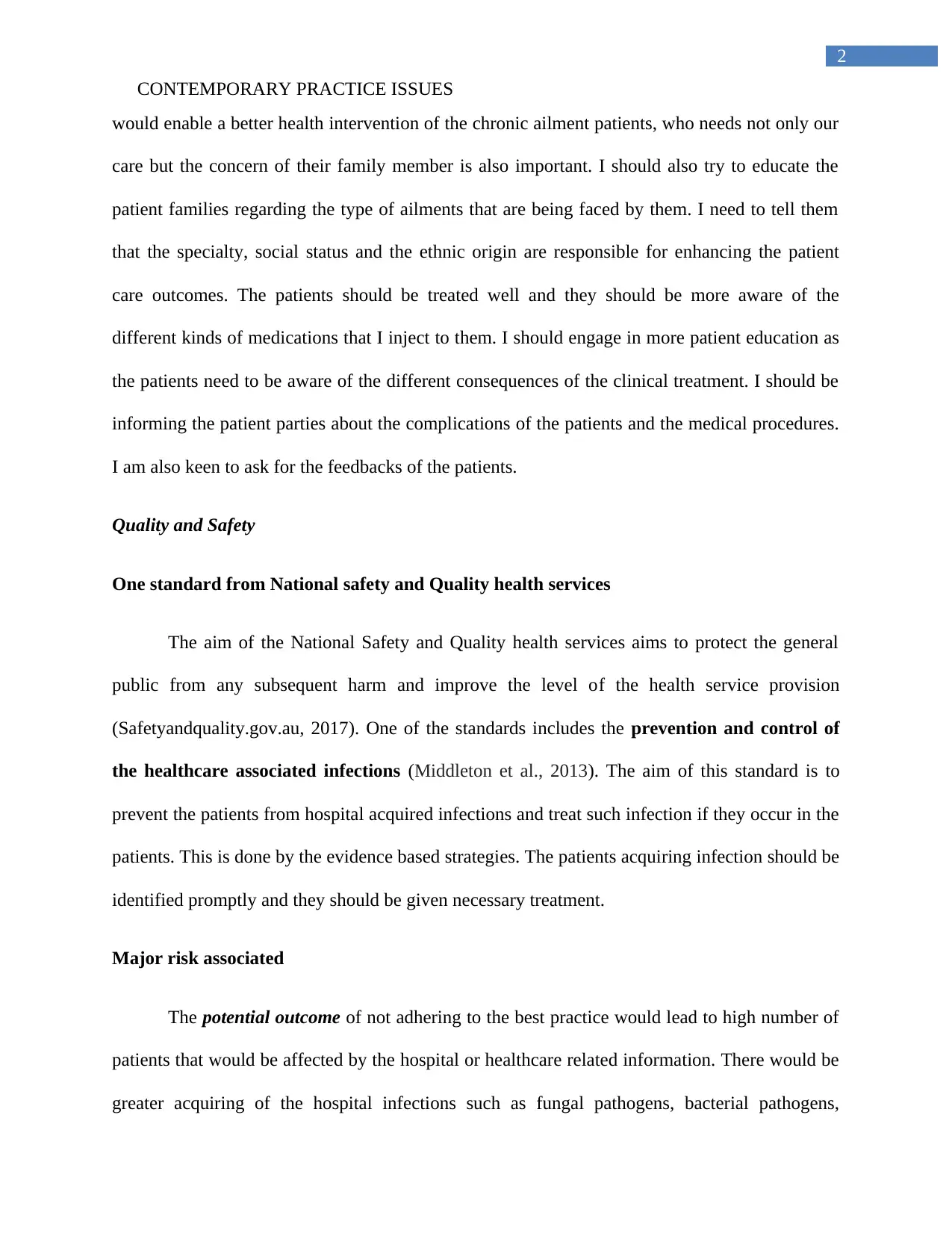
2
CONTEMPORARY PRACTICE ISSUES
would enable a better health intervention of the chronic ailment patients, who needs not only our
care but the concern of their family member is also important. I should also try to educate the
patient families regarding the type of ailments that are being faced by them. I need to tell them
that the specialty, social status and the ethnic origin are responsible for enhancing the patient
care outcomes. The patients should be treated well and they should be more aware of the
different kinds of medications that I inject to them. I should engage in more patient education as
the patients need to be aware of the different consequences of the clinical treatment. I should be
informing the patient parties about the complications of the patients and the medical procedures.
I am also keen to ask for the feedbacks of the patients.
Quality and Safety
One standard from National safety and Quality health services
The aim of the National Safety and Quality health services aims to protect the general
public from any subsequent harm and improve the level of the health service provision
(Safetyandquality.gov.au, 2017). One of the standards includes the prevention and control of
the healthcare associated infections (Middleton et al., 2013). The aim of this standard is to
prevent the patients from hospital acquired infections and treat such infection if they occur in the
patients. This is done by the evidence based strategies. The patients acquiring infection should be
identified promptly and they should be given necessary treatment.
Major risk associated
The potential outcome of not adhering to the best practice would lead to high number of
patients that would be affected by the hospital or healthcare related information. There would be
greater acquiring of the hospital infections such as fungal pathogens, bacterial pathogens,
CONTEMPORARY PRACTICE ISSUES
would enable a better health intervention of the chronic ailment patients, who needs not only our
care but the concern of their family member is also important. I should also try to educate the
patient families regarding the type of ailments that are being faced by them. I need to tell them
that the specialty, social status and the ethnic origin are responsible for enhancing the patient
care outcomes. The patients should be treated well and they should be more aware of the
different kinds of medications that I inject to them. I should engage in more patient education as
the patients need to be aware of the different consequences of the clinical treatment. I should be
informing the patient parties about the complications of the patients and the medical procedures.
I am also keen to ask for the feedbacks of the patients.
Quality and Safety
One standard from National safety and Quality health services
The aim of the National Safety and Quality health services aims to protect the general
public from any subsequent harm and improve the level of the health service provision
(Safetyandquality.gov.au, 2017). One of the standards includes the prevention and control of
the healthcare associated infections (Middleton et al., 2013). The aim of this standard is to
prevent the patients from hospital acquired infections and treat such infection if they occur in the
patients. This is done by the evidence based strategies. The patients acquiring infection should be
identified promptly and they should be given necessary treatment.
Major risk associated
The potential outcome of not adhering to the best practice would lead to high number of
patients that would be affected by the hospital or healthcare related information. There would be
greater acquiring of the hospital infections such as fungal pathogens, bacterial pathogens,
⊘ This is a preview!⊘
Do you want full access?
Subscribe today to unlock all pages.

Trusted by 1+ million students worldwide
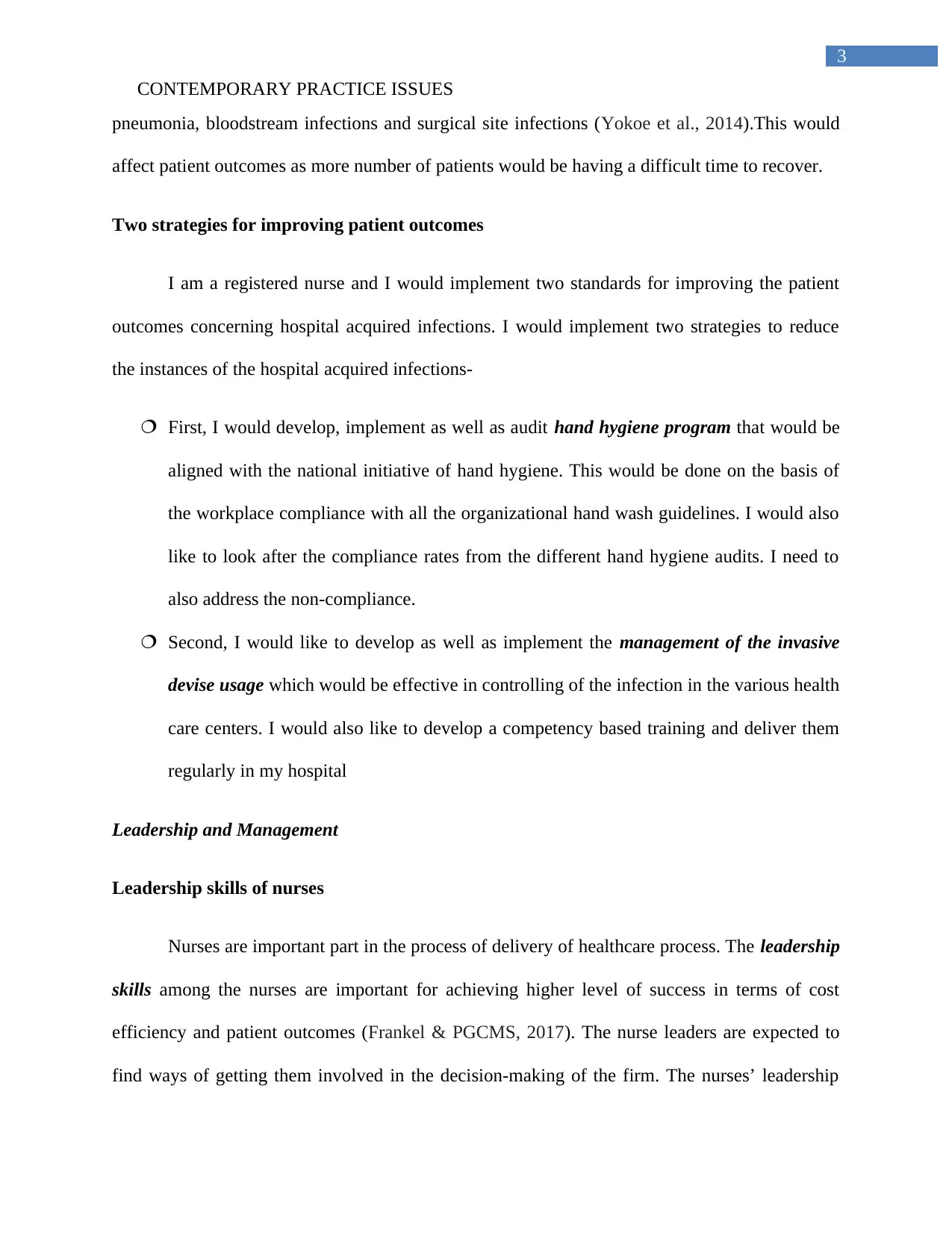
3
CONTEMPORARY PRACTICE ISSUES
pneumonia, bloodstream infections and surgical site infections (Yokoe et al., 2014).This would
affect patient outcomes as more number of patients would be having a difficult time to recover.
Two strategies for improving patient outcomes
I am a registered nurse and I would implement two standards for improving the patient
outcomes concerning hospital acquired infections. I would implement two strategies to reduce
the instances of the hospital acquired infections-
First, I would develop, implement as well as audit hand hygiene program that would be
aligned with the national initiative of hand hygiene. This would be done on the basis of
the workplace compliance with all the organizational hand wash guidelines. I would also
like to look after the compliance rates from the different hand hygiene audits. I need to
also address the non-compliance.
Second, I would like to develop as well as implement the management of the invasive
devise usage which would be effective in controlling of the infection in the various health
care centers. I would also like to develop a competency based training and deliver them
regularly in my hospital
Leadership and Management
Leadership skills of nurses
Nurses are important part in the process of delivery of healthcare process. The leadership
skills among the nurses are important for achieving higher level of success in terms of cost
efficiency and patient outcomes (Frankel & PGCMS, 2017). The nurse leaders are expected to
find ways of getting them involved in the decision-making of the firm. The nurses’ leadership
CONTEMPORARY PRACTICE ISSUES
pneumonia, bloodstream infections and surgical site infections (Yokoe et al., 2014).This would
affect patient outcomes as more number of patients would be having a difficult time to recover.
Two strategies for improving patient outcomes
I am a registered nurse and I would implement two standards for improving the patient
outcomes concerning hospital acquired infections. I would implement two strategies to reduce
the instances of the hospital acquired infections-
First, I would develop, implement as well as audit hand hygiene program that would be
aligned with the national initiative of hand hygiene. This would be done on the basis of
the workplace compliance with all the organizational hand wash guidelines. I would also
like to look after the compliance rates from the different hand hygiene audits. I need to
also address the non-compliance.
Second, I would like to develop as well as implement the management of the invasive
devise usage which would be effective in controlling of the infection in the various health
care centers. I would also like to develop a competency based training and deliver them
regularly in my hospital
Leadership and Management
Leadership skills of nurses
Nurses are important part in the process of delivery of healthcare process. The leadership
skills among the nurses are important for achieving higher level of success in terms of cost
efficiency and patient outcomes (Frankel & PGCMS, 2017). The nurse leaders are expected to
find ways of getting them involved in the decision-making of the firm. The nurses’ leadership
Paraphrase This Document
Need a fresh take? Get an instant paraphrase of this document with our AI Paraphraser

4
CONTEMPORARY PRACTICE ISSUES
capabilities have direct impact on workforce planning and the development of suitable workplace
policies.
One of the most important leadership skills of the nurses includes the mentorship
activities. The senior nurses should involve in empowering their junior team members and focus
on the importance of the nursing role. The mentorship should be a structured one and they should
be task specific instead of normal training. The senior nurses must ensure that the juniors have
their right to seek proper information and there should be proper exchange of the useful
knowledge (Reem, Kitsantas & Maddox, 2014). The aim of the mentorship is to create
supportive a stable work environment that would encourage professional growth. It is also
important to implement role modeling in which the less experienced nurses would be gaining
experience from the more experienced ones.
The nurses should also strive their nursing team to have better outcomes for patient care.
The good leaders are expected to give encouragement to the junior staff so that they can gain a
better understanding of the patient needs (Grossman & Valiga, 2016). It is important for the
senior leaders to identify their roles and optimize the patient outcomes.
Development of strategies for skill development
I think I should develop myself as a better mentor as the empowered nurses to enhance
their commitment to the organizational goals. I should try to enhance my coaching capabilities
and should encourage that the senior nurses should take care of this activity for around 15-30
minutes every day. I should try to complete a daily log, in which there would be proper
documentation of the mentorship task. It is also important to understand the strengths as well as
CONTEMPORARY PRACTICE ISSUES
capabilities have direct impact on workforce planning and the development of suitable workplace
policies.
One of the most important leadership skills of the nurses includes the mentorship
activities. The senior nurses should involve in empowering their junior team members and focus
on the importance of the nursing role. The mentorship should be a structured one and they should
be task specific instead of normal training. The senior nurses must ensure that the juniors have
their right to seek proper information and there should be proper exchange of the useful
knowledge (Reem, Kitsantas & Maddox, 2014). The aim of the mentorship is to create
supportive a stable work environment that would encourage professional growth. It is also
important to implement role modeling in which the less experienced nurses would be gaining
experience from the more experienced ones.
The nurses should also strive their nursing team to have better outcomes for patient care.
The good leaders are expected to give encouragement to the junior staff so that they can gain a
better understanding of the patient needs (Grossman & Valiga, 2016). It is important for the
senior leaders to identify their roles and optimize the patient outcomes.
Development of strategies for skill development
I think I should develop myself as a better mentor as the empowered nurses to enhance
their commitment to the organizational goals. I should try to enhance my coaching capabilities
and should encourage that the senior nurses should take care of this activity for around 15-30
minutes every day. I should try to complete a daily log, in which there would be proper
documentation of the mentorship task. It is also important to understand the strengths as well as
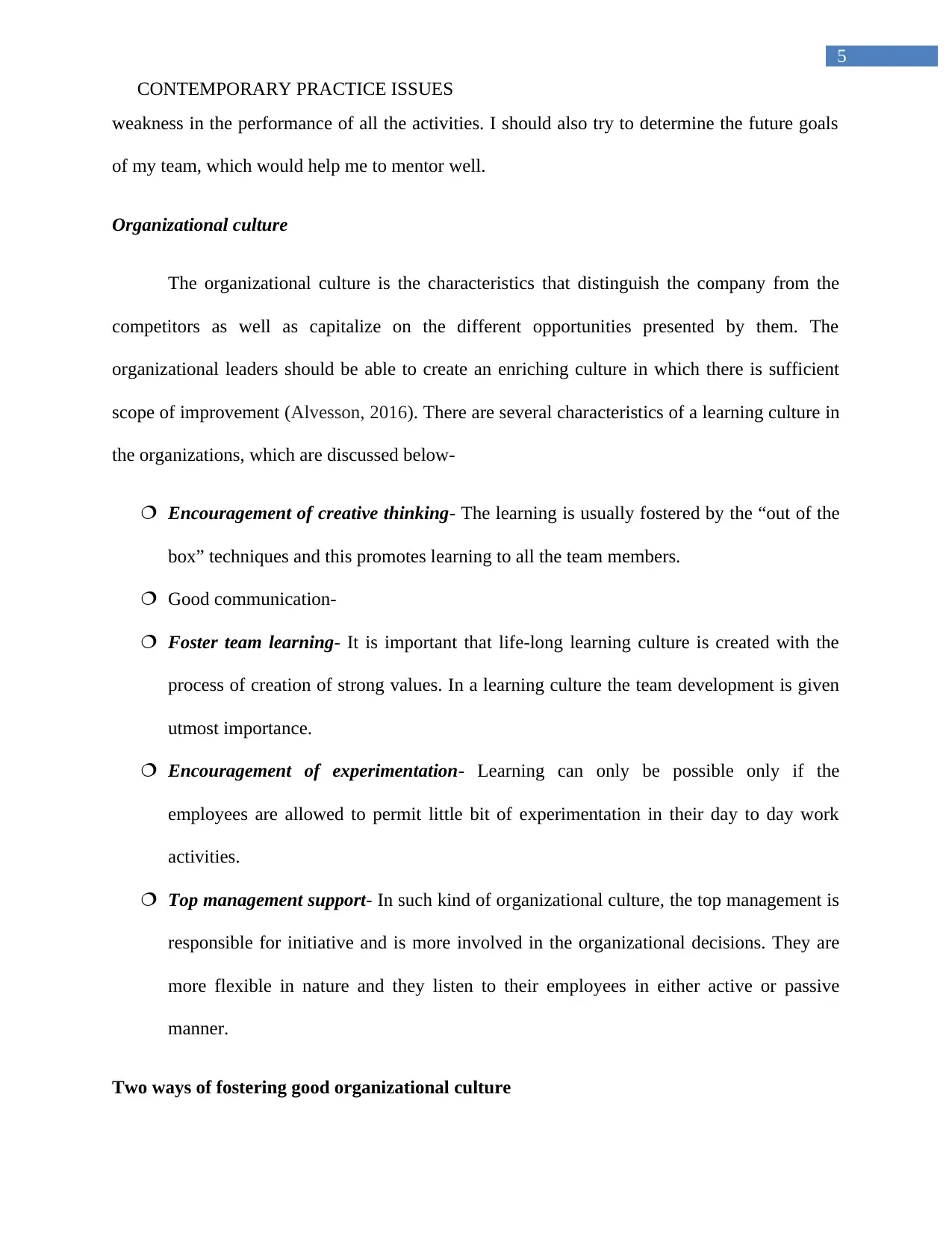
5
CONTEMPORARY PRACTICE ISSUES
weakness in the performance of all the activities. I should also try to determine the future goals
of my team, which would help me to mentor well.
Organizational culture
The organizational culture is the characteristics that distinguish the company from the
competitors as well as capitalize on the different opportunities presented by them. The
organizational leaders should be able to create an enriching culture in which there is sufficient
scope of improvement (Alvesson, 2016). There are several characteristics of a learning culture in
the organizations, which are discussed below-
Encouragement of creative thinking- The learning is usually fostered by the “out of the
box” techniques and this promotes learning to all the team members.
Good communication-
Foster team learning- It is important that life-long learning culture is created with the
process of creation of strong values. In a learning culture the team development is given
utmost importance.
Encouragement of experimentation- Learning can only be possible only if the
employees are allowed to permit little bit of experimentation in their day to day work
activities.
Top management support- In such kind of organizational culture, the top management is
responsible for initiative and is more involved in the organizational decisions. They are
more flexible in nature and they listen to their employees in either active or passive
manner.
Two ways of fostering good organizational culture
CONTEMPORARY PRACTICE ISSUES
weakness in the performance of all the activities. I should also try to determine the future goals
of my team, which would help me to mentor well.
Organizational culture
The organizational culture is the characteristics that distinguish the company from the
competitors as well as capitalize on the different opportunities presented by them. The
organizational leaders should be able to create an enriching culture in which there is sufficient
scope of improvement (Alvesson, 2016). There are several characteristics of a learning culture in
the organizations, which are discussed below-
Encouragement of creative thinking- The learning is usually fostered by the “out of the
box” techniques and this promotes learning to all the team members.
Good communication-
Foster team learning- It is important that life-long learning culture is created with the
process of creation of strong values. In a learning culture the team development is given
utmost importance.
Encouragement of experimentation- Learning can only be possible only if the
employees are allowed to permit little bit of experimentation in their day to day work
activities.
Top management support- In such kind of organizational culture, the top management is
responsible for initiative and is more involved in the organizational decisions. They are
more flexible in nature and they listen to their employees in either active or passive
manner.
Two ways of fostering good organizational culture
⊘ This is a preview!⊘
Do you want full access?
Subscribe today to unlock all pages.

Trusted by 1+ million students worldwide
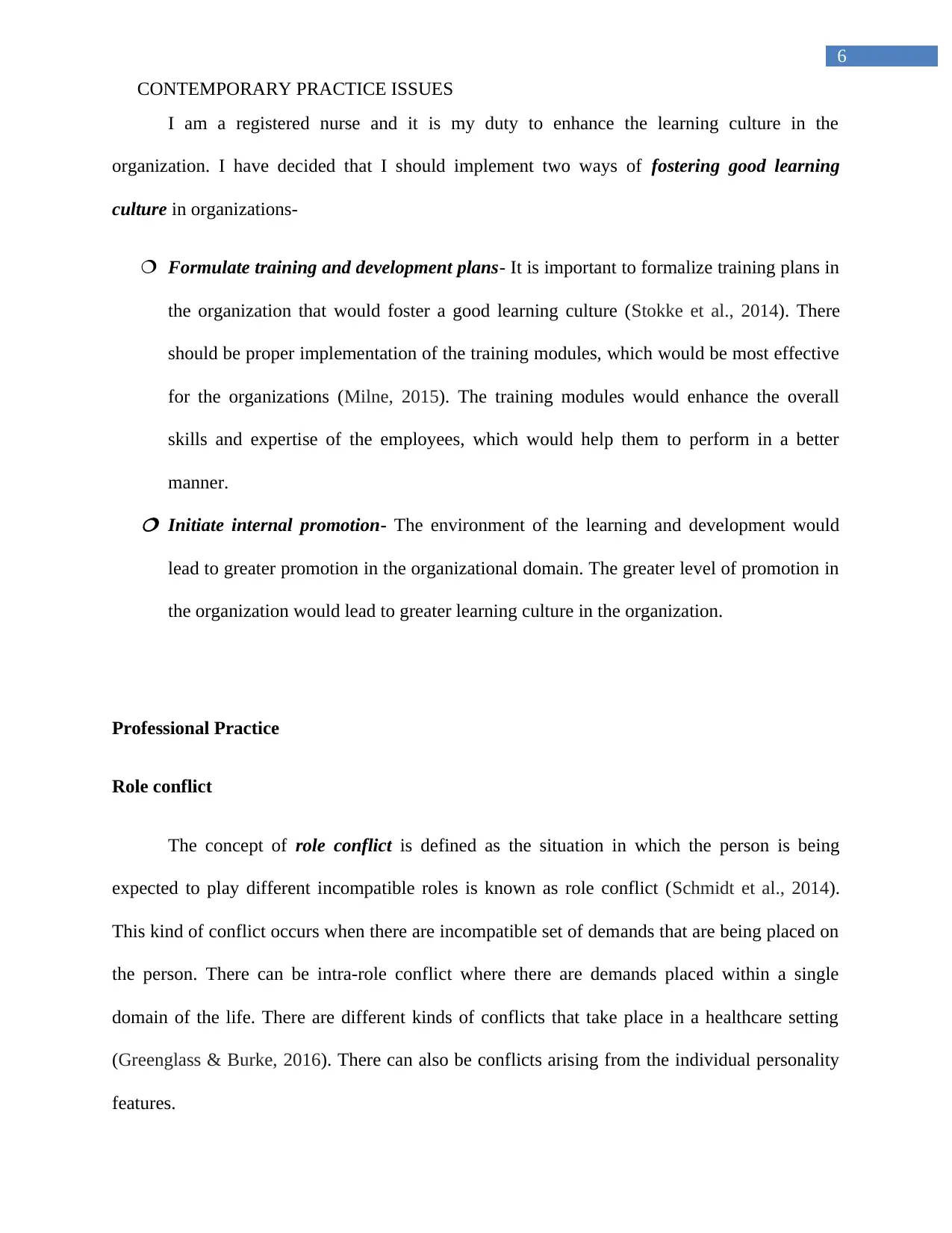
6
CONTEMPORARY PRACTICE ISSUES
I am a registered nurse and it is my duty to enhance the learning culture in the
organization. I have decided that I should implement two ways of fostering good learning
culture in organizations-
Formulate training and development plans- It is important to formalize training plans in
the organization that would foster a good learning culture (Stokke et al., 2014). There
should be proper implementation of the training modules, which would be most effective
for the organizations (Milne, 2015). The training modules would enhance the overall
skills and expertise of the employees, which would help them to perform in a better
manner. Initiate internal promotion- The environment of the learning and development would
lead to greater promotion in the organizational domain. The greater level of promotion in
the organization would lead to greater learning culture in the organization.
Professional Practice
Role conflict
The concept of role conflict is defined as the situation in which the person is being
expected to play different incompatible roles is known as role conflict (Schmidt et al., 2014).
This kind of conflict occurs when there are incompatible set of demands that are being placed on
the person. There can be intra-role conflict where there are demands placed within a single
domain of the life. There are different kinds of conflicts that take place in a healthcare setting
(Greenglass & Burke, 2016). There can also be conflicts arising from the individual personality
features.
CONTEMPORARY PRACTICE ISSUES
I am a registered nurse and it is my duty to enhance the learning culture in the
organization. I have decided that I should implement two ways of fostering good learning
culture in organizations-
Formulate training and development plans- It is important to formalize training plans in
the organization that would foster a good learning culture (Stokke et al., 2014). There
should be proper implementation of the training modules, which would be most effective
for the organizations (Milne, 2015). The training modules would enhance the overall
skills and expertise of the employees, which would help them to perform in a better
manner. Initiate internal promotion- The environment of the learning and development would
lead to greater promotion in the organizational domain. The greater level of promotion in
the organization would lead to greater learning culture in the organization.
Professional Practice
Role conflict
The concept of role conflict is defined as the situation in which the person is being
expected to play different incompatible roles is known as role conflict (Schmidt et al., 2014).
This kind of conflict occurs when there are incompatible set of demands that are being placed on
the person. There can be intra-role conflict where there are demands placed within a single
domain of the life. There are different kinds of conflicts that take place in a healthcare setting
(Greenglass & Burke, 2016). There can also be conflicts arising from the individual personality
features.
Paraphrase This Document
Need a fresh take? Get an instant paraphrase of this document with our AI Paraphraser

7
CONTEMPORARY PRACTICE ISSUES
The role conflict has an effect on the functioning of a nurse in a healthcare scenario. The
nurses may not be able to adhere to the patient care guidelines if there are conflicts in between
the team (Fiabane et al., 2013). The high level of conflicts would lead to an increase in the
employee demotivation, which would decrease the performance of the nurses. If the employees
have low morale, then they would not be able to serve the patients in a better way. This would
subsequently decrease the patient satisfaction rates, which would not be good from the
organizational point of view. It would imply a subsequent reduction in the revenue generation of
the hospital or the healthcare entity.
Two self-care strategies
I should adopt two self-care strategies that would help in the physical and emotional well
being of myself. I should be aware about the fact that it is important to build amicable
relationships with all the medical team members of the hospital. It is also advisable to build good
rapport with the administrative staffs of the hospital so that the overall patient care can be
enhanced. I should also keep in mind the fact that I need to go frequent trainings, which would
enhance my performance. If the employees are being given more number of skills and expertise,
then they would be happy in the workplace. I need to focus on reducing the level of conflicts in
the organization and should try to improve the interpersonal relationships. I should try to focus
on the various aspects of the interpersonal relationships in the organization and should try to
improve them as much as possible.
CONTEMPORARY PRACTICE ISSUES
The role conflict has an effect on the functioning of a nurse in a healthcare scenario. The
nurses may not be able to adhere to the patient care guidelines if there are conflicts in between
the team (Fiabane et al., 2013). The high level of conflicts would lead to an increase in the
employee demotivation, which would decrease the performance of the nurses. If the employees
have low morale, then they would not be able to serve the patients in a better way. This would
subsequently decrease the patient satisfaction rates, which would not be good from the
organizational point of view. It would imply a subsequent reduction in the revenue generation of
the hospital or the healthcare entity.
Two self-care strategies
I should adopt two self-care strategies that would help in the physical and emotional well
being of myself. I should be aware about the fact that it is important to build amicable
relationships with all the medical team members of the hospital. It is also advisable to build good
rapport with the administrative staffs of the hospital so that the overall patient care can be
enhanced. I should also keep in mind the fact that I need to go frequent trainings, which would
enhance my performance. If the employees are being given more number of skills and expertise,
then they would be happy in the workplace. I need to focus on reducing the level of conflicts in
the organization and should try to improve the interpersonal relationships. I should try to focus
on the various aspects of the interpersonal relationships in the organization and should try to
improve them as much as possible.
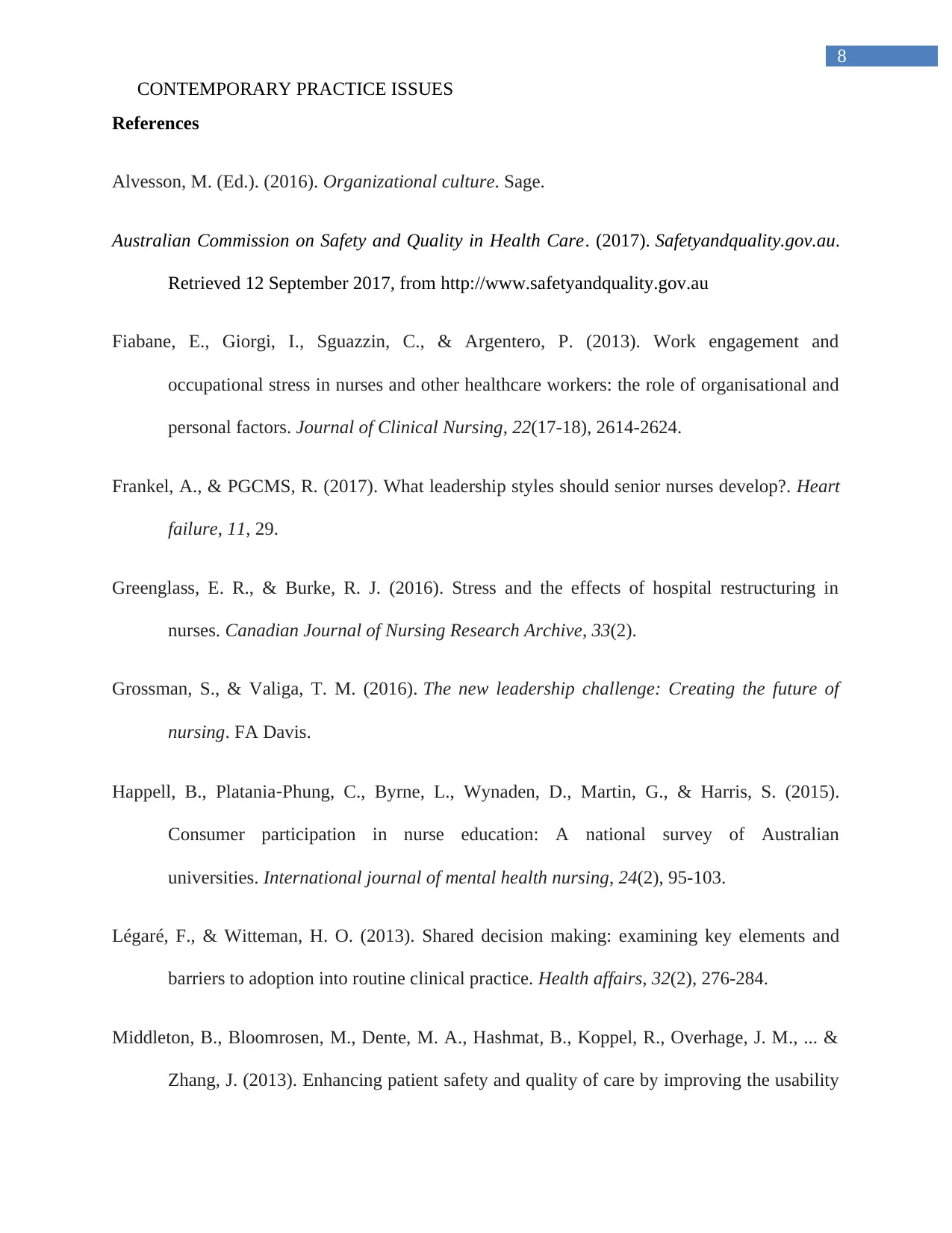
8
CONTEMPORARY PRACTICE ISSUES
References
Alvesson, M. (Ed.). (2016). Organizational culture. Sage.
Australian Commission on Safety and Quality in Health Care. (2017). Safetyandquality.gov.au.
Retrieved 12 September 2017, from http://www.safetyandquality.gov.au
Fiabane, E., Giorgi, I., Sguazzin, C., & Argentero, P. (2013). Work engagement and
occupational stress in nurses and other healthcare workers: the role of organisational and
personal factors. Journal of Clinical Nursing, 22(17-18), 2614-2624.
Frankel, A., & PGCMS, R. (2017). What leadership styles should senior nurses develop?. Heart
failure, 11, 29.
Greenglass, E. R., & Burke, R. J. (2016). Stress and the effects of hospital restructuring in
nurses. Canadian Journal of Nursing Research Archive, 33(2).
Grossman, S., & Valiga, T. M. (2016). The new leadership challenge: Creating the future of
nursing. FA Davis.
Happell, B., Platania‐Phung, C., Byrne, L., Wynaden, D., Martin, G., & Harris, S. (2015).
Consumer participation in nurse education: A national survey of Australian
universities. International journal of mental health nursing, 24(2), 95-103.
Légaré, F., & Witteman, H. O. (2013). Shared decision making: examining key elements and
barriers to adoption into routine clinical practice. Health affairs, 32(2), 276-284.
Middleton, B., Bloomrosen, M., Dente, M. A., Hashmat, B., Koppel, R., Overhage, J. M., ... &
Zhang, J. (2013). Enhancing patient safety and quality of care by improving the usability
CONTEMPORARY PRACTICE ISSUES
References
Alvesson, M. (Ed.). (2016). Organizational culture. Sage.
Australian Commission on Safety and Quality in Health Care. (2017). Safetyandquality.gov.au.
Retrieved 12 September 2017, from http://www.safetyandquality.gov.au
Fiabane, E., Giorgi, I., Sguazzin, C., & Argentero, P. (2013). Work engagement and
occupational stress in nurses and other healthcare workers: the role of organisational and
personal factors. Journal of Clinical Nursing, 22(17-18), 2614-2624.
Frankel, A., & PGCMS, R. (2017). What leadership styles should senior nurses develop?. Heart
failure, 11, 29.
Greenglass, E. R., & Burke, R. J. (2016). Stress and the effects of hospital restructuring in
nurses. Canadian Journal of Nursing Research Archive, 33(2).
Grossman, S., & Valiga, T. M. (2016). The new leadership challenge: Creating the future of
nursing. FA Davis.
Happell, B., Platania‐Phung, C., Byrne, L., Wynaden, D., Martin, G., & Harris, S. (2015).
Consumer participation in nurse education: A national survey of Australian
universities. International journal of mental health nursing, 24(2), 95-103.
Légaré, F., & Witteman, H. O. (2013). Shared decision making: examining key elements and
barriers to adoption into routine clinical practice. Health affairs, 32(2), 276-284.
Middleton, B., Bloomrosen, M., Dente, M. A., Hashmat, B., Koppel, R., Overhage, J. M., ... &
Zhang, J. (2013). Enhancing patient safety and quality of care by improving the usability
⊘ This is a preview!⊘
Do you want full access?
Subscribe today to unlock all pages.

Trusted by 1+ million students worldwide
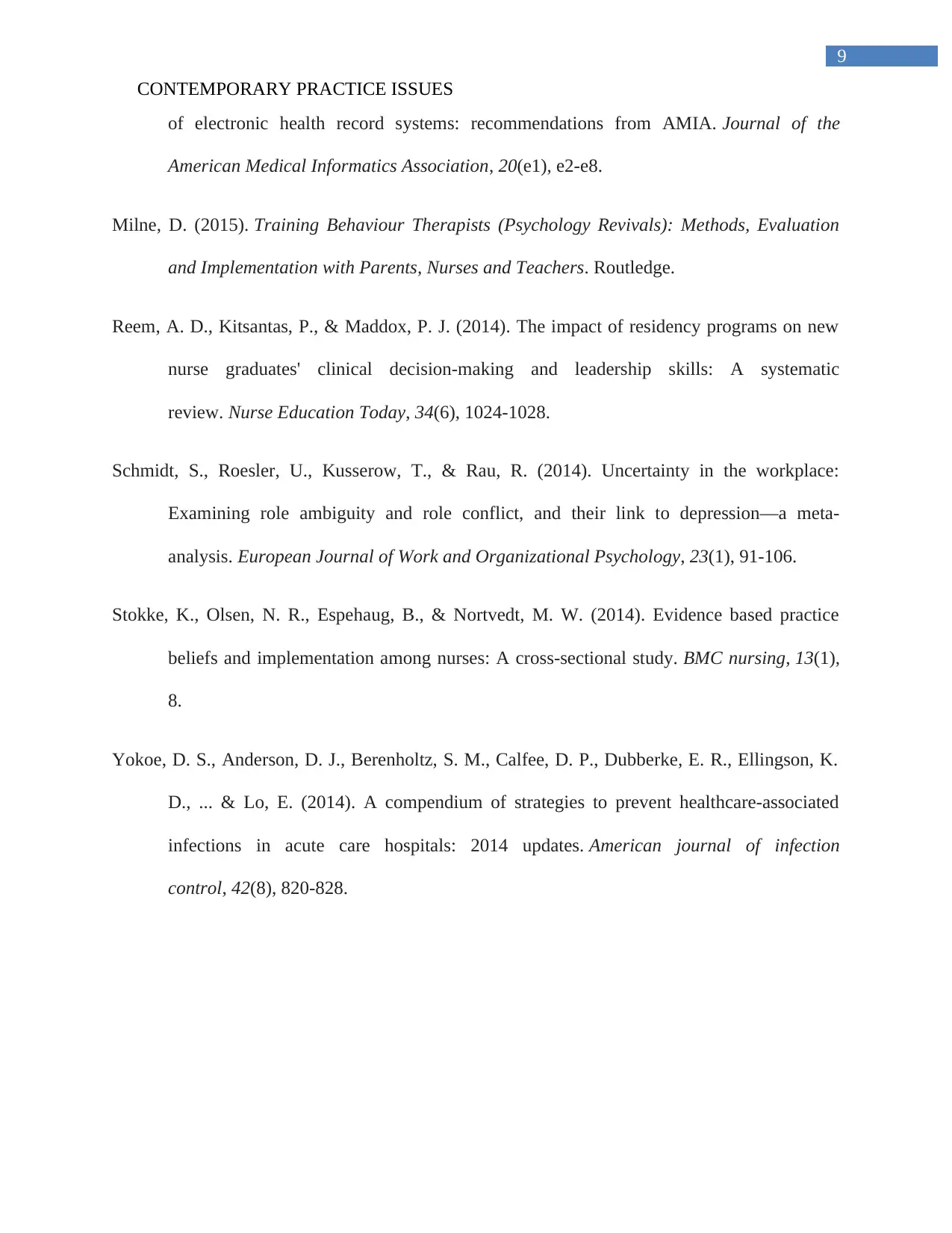
9
CONTEMPORARY PRACTICE ISSUES
of electronic health record systems: recommendations from AMIA. Journal of the
American Medical Informatics Association, 20(e1), e2-e8.
Milne, D. (2015). Training Behaviour Therapists (Psychology Revivals): Methods, Evaluation
and Implementation with Parents, Nurses and Teachers. Routledge.
Reem, A. D., Kitsantas, P., & Maddox, P. J. (2014). The impact of residency programs on new
nurse graduates' clinical decision-making and leadership skills: A systematic
review. Nurse Education Today, 34(6), 1024-1028.
Schmidt, S., Roesler, U., Kusserow, T., & Rau, R. (2014). Uncertainty in the workplace:
Examining role ambiguity and role conflict, and their link to depression—a meta-
analysis. European Journal of Work and Organizational Psychology, 23(1), 91-106.
Stokke, K., Olsen, N. R., Espehaug, B., & Nortvedt, M. W. (2014). Evidence based practice
beliefs and implementation among nurses: A cross-sectional study. BMC nursing, 13(1),
8.
Yokoe, D. S., Anderson, D. J., Berenholtz, S. M., Calfee, D. P., Dubberke, E. R., Ellingson, K.
D., ... & Lo, E. (2014). A compendium of strategies to prevent healthcare-associated
infections in acute care hospitals: 2014 updates. American journal of infection
control, 42(8), 820-828.
CONTEMPORARY PRACTICE ISSUES
of electronic health record systems: recommendations from AMIA. Journal of the
American Medical Informatics Association, 20(e1), e2-e8.
Milne, D. (2015). Training Behaviour Therapists (Psychology Revivals): Methods, Evaluation
and Implementation with Parents, Nurses and Teachers. Routledge.
Reem, A. D., Kitsantas, P., & Maddox, P. J. (2014). The impact of residency programs on new
nurse graduates' clinical decision-making and leadership skills: A systematic
review. Nurse Education Today, 34(6), 1024-1028.
Schmidt, S., Roesler, U., Kusserow, T., & Rau, R. (2014). Uncertainty in the workplace:
Examining role ambiguity and role conflict, and their link to depression—a meta-
analysis. European Journal of Work and Organizational Psychology, 23(1), 91-106.
Stokke, K., Olsen, N. R., Espehaug, B., & Nortvedt, M. W. (2014). Evidence based practice
beliefs and implementation among nurses: A cross-sectional study. BMC nursing, 13(1),
8.
Yokoe, D. S., Anderson, D. J., Berenholtz, S. M., Calfee, D. P., Dubberke, E. R., Ellingson, K.
D., ... & Lo, E. (2014). A compendium of strategies to prevent healthcare-associated
infections in acute care hospitals: 2014 updates. American journal of infection
control, 42(8), 820-828.
Paraphrase This Document
Need a fresh take? Get an instant paraphrase of this document with our AI Paraphraser

10
CONTEMPORARY PRACTICE ISSUES
Bibliography
Hamine, S., Gerth-Guyette, E., Faulx, D., Green, B. B., & Ginsburg, A. S. (2015). Impact of
mHealth chronic disease management on treatment adherence and patient outcomes: a
systematic review. Journal of medical Internet research, 17(2).
Smith, J., Odera, D. N., Chege, D., Muigai, E. N., Patnaik, P., Michaels-Strasser, S., ... & Dohrn,
J. (2016). Identifying the Gaps: An Assessment of Nurses' Training, Competency, and
Practice in HIV Care and Treatment in Kenya. Journal of the Association of Nurses in
AIDS Care, 27(3), 322-330.
CONTEMPORARY PRACTICE ISSUES
Bibliography
Hamine, S., Gerth-Guyette, E., Faulx, D., Green, B. B., & Ginsburg, A. S. (2015). Impact of
mHealth chronic disease management on treatment adherence and patient outcomes: a
systematic review. Journal of medical Internet research, 17(2).
Smith, J., Odera, D. N., Chege, D., Muigai, E. N., Patnaik, P., Michaels-Strasser, S., ... & Dohrn,
J. (2016). Identifying the Gaps: An Assessment of Nurses' Training, Competency, and
Practice in HIV Care and Treatment in Kenya. Journal of the Association of Nurses in
AIDS Care, 27(3), 322-330.
1 out of 11
Related Documents
Your All-in-One AI-Powered Toolkit for Academic Success.
+13062052269
info@desklib.com
Available 24*7 on WhatsApp / Email
![[object Object]](/_next/static/media/star-bottom.7253800d.svg)
Unlock your academic potential
Copyright © 2020–2025 A2Z Services. All Rights Reserved. Developed and managed by ZUCOL.





